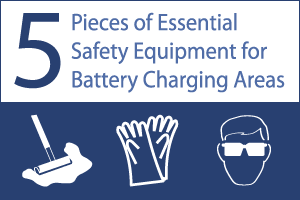We use cookies to make your experience better. To comply with the new e-Privacy directive, we need to ask for your consent to set the cookies. Learn more.
5 Pieces of Essential Safety Equipment for Battery Charging Areas

While forklift batteries present some challenges, they are extremely safe when paired with appropriate safety equipment and well-trained personnel. In fact, with some planning, the process of changing and charging lift truck batteries can be as safe as filling a car’s gas tank.
Battery room hazards are usually related to four specific issues: the great weight of the batteries, the corrosive electrolyte in flooded lead/acid cells, electrical current at terminals and within cells, and the potentially explosive gasses generated by the charging process. Each of these hazards can be easily controlled — and danger can be mitigated — with appropriate safety gear and equipment.
By ensuring easy access to a few crucial pieces of safety equipment, battery room managers can keep their operations safe and accident free. Many of these items are required by federal, state, and local regulations as well; contact your nearest OSHA office for more information on compliance.
Protecting Personnel and Equipment During Battery Handling Tasks
While it sounds cliché, the training manual is the most important piece of safety equipment for battery room personnel. Regular training is essential, and whether batteries are changed by lift truck operators or by designated battery room staff, training will eliminate most hazards.
Ongoing training in all aspects of forklift operation is required by OSHA 1910.178, the regulation that governs powered industrial trucks. OSHA standard 1910.178(l)(3)(i)(k) specifically requires forklift training programs to address the charging and recharging of batteries for electric fleets.
Employers must also provide personnel with adequate safety equipment in all battery charging areas. The following items will help to prevent accidents and equipment damage while allowing for more efficient battery changes:
-
Personal Protective Equipment
- The electrolyte in flooded battery cells contains sulfuric acid, which is highly corrosive. Protective clothing can help to prevent contact and ensure the safety of personnel.According to OSHA 1910.132, employers must provide adequate personal protective equipment. For personnel who handle forklift batteries, this might include an acid-resistant apron, boots, and gloves, along with a face shield and goggles designed to resist chemical splashes. The BHS Personal Protective Kit is a good example of personal protective equipment that can keep battery room personnel safe.
-
Spill kits
- Even in the most well-run operations, accidents will occasionally occur. When electrolyte spills out of battery cases, it is important to have easy access to the resources that can neutralize the acidic mixture.Battery rooms should be outfitted with acid neutralizers and absorbent pads to clean electrolyte leaks or spills. BHS Battery Spill Kits include everything needed to neutralize and eliminate the acid/water solution found in flooded battery cells.
-
Ventilation Systems
- Air quality is particularly important in battery rooms, since the charging process creates hydrogen that can quickly build to dangerous concentrations. Adequate venting is crucial (along with signage that tells personnel not to smoke or bring open flames into the area).Trade journal Modern Materials Handling reports that a hydrogen concentration of just four percent creates an explosion risk. To avoid reaching this point, hydrogen detectors paired with reliable venting equipment, such as the BHS Battery Room Ventilation System, should be employed in all battery charging areas.
-
Eye wash stations
-The first few seconds of contact with a corrosive substance will directly affect the severity of any resulting injuries. Eye wash stations should be available in every battery room for immediate flushing in case of contact with acid or electrolyte, as required by OSHA standard 1910.151(c).The best practices for installing and maintaining flushing stations are detailed by the American National Standards Institute in ANSI Z358.1. Consult this document for more details.
-
Clear Signs and Labels.
Clearly labeling potential hazards can help prevent an accident, and marking locations of safety equipment with bold signage encourages a quicker response if mishaps do occur.The importance of signage in the battery room is reflected by the standards and regulations that require clear labeling. For more information on using signs and postings in battery rooms, refer to our previous post on the subject.
Empowering Personnel to Safely Handle Forklift Batteries
In addition to the safety equipment addressed above, employers should provide battery handling equipment that makes battery changes easy for personnel. The full line of BHS Battery Extractors allows personnel to safely change forklift batteries of virtually any size.
By employing adequate safety equipment and quality battery handling devices, electric forklift fleets can provide operations with the motive power they need without excessive risks.
Safety equipment allows for a safe and productive battery room — and a better work environment for employees.
References:
Bond, Josh. "Minimizing the risk of explosion in the battery room: the mere possibility of a hydrogen ignition can lead to big costs for an operation, but a solid monitoring plan can put workers, inspectors and insurance companies at ease." Modern Materials Handling 2013: 16. General OneFile. Web. 2 June 2015.
Kaletta, James. “Lift trucks: Battery room safety tips.” Modern Materials Handling 27 Oct. 2010. Web. 2 June 2015.
“Emergency Eye Wash and Shower Units.” Office of Compliance Fast Facts Dec. 2007. PDF. 2 June 2015.
"Powered Industrial Trucks ETool: Types & Fundamentals - Power Sources: Electric." Powered Industrial Trucks ETool: Types & Fundamentals - Power Sources: Electric. U.S. Department of Labor, Occupational Safety & Health Administration, n.d. Web. 02 June 2015.
